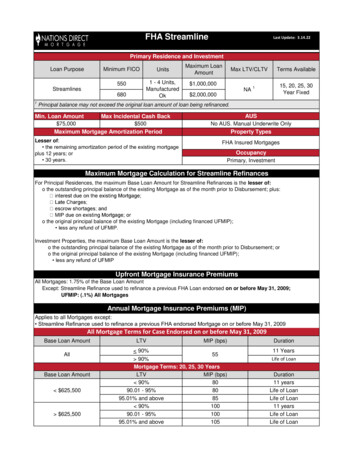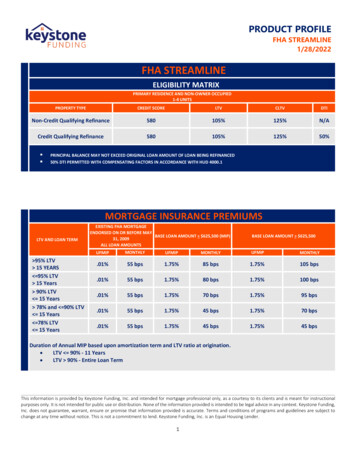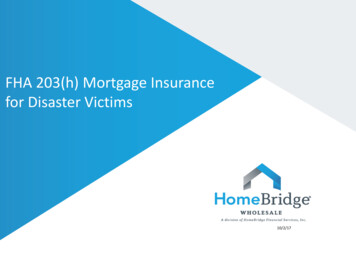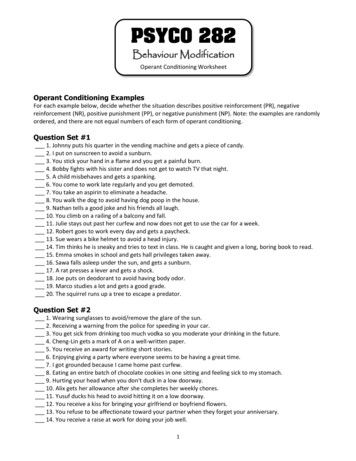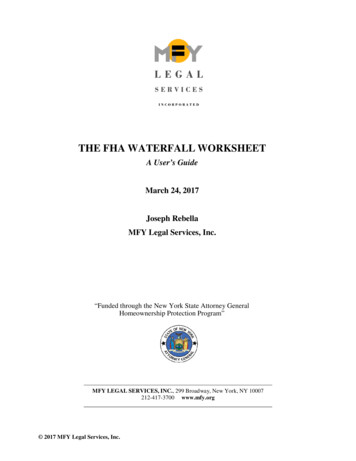
Transcription
THE FHA WATERFALL WORKSHEETA User’s GuideMarch 24, 2017Joseph RebellaMFY Legal Services, Inc.“Funded through the New York State Attorney GeneralHomeownership Protection Program”MFY LEGAL SERVICES, INC., 299 Broadway, New York, NY 10007212-417-3700 www.mfy.org 2017 MFY Legal Services, Inc.
The FHA Waterfall WorksheetA User’s GuideMarch 24, 2017Table of ContentsI.About MFY’s FHA Waterfall Worksheet. 1II.Introduction to FHA Loss Mitigation . 1III.IV.V.A.History and Functions of the Federal Housing Administration . 1B.Sources of FHA Rules .3FHA Loss Mitigation . 3A.FHA Loss Mitigation Eligibility Requirements . 3B.FHA Loss Mitigation Terms . 4C.FHA Loss Mitigation Options . 61.Forbearance Plans . 62.FHA-HAMP . 7Using the FHA Waterfall Worksheet . 9A.Introduction . 9B.Waterfall Inputs . 9C.Waterfall Outputs . 14FHA Loss Mitigation Examples . 14A.FHA- HAMP Stand-Alone Partial Claim . 15B.FHA-HAMP Stand-Alone Loan Modification . 19C.FHA-HAMP Loan Modification with Partial Claim . 22D.FHA-HAMP Loan Modification above the Target Payment . 26 2017 MFY Legal Services, Inc.i
The FHA Waterfall WorksheetA User’s GuideMarch 24, 2017I.About MFY’s FHA Waterfall WorksheetMFY’s FHA Waterfall Worksheet (the “Worksheet”) is designed to determine borrowereligibility for FHA home retention loss mitigation options based on the criteria set out inMortgagee Letter 2016-14 and integrated into the Single Family Housing Policy Handbook,4000.1. The Worksheet provides detailed information about potential outcomes and createsevidence of loss mitigation eligibility to oppose wrongful denials. The Worksheet does notsubstitute for an understanding of FHA guidelines. The Worksheet only runs the waterfalldescribed in FHA’s guidance.It does not consider other restrictions such as previousmodifications, owner occupancy, etc. It also does not consider a borrower for loss mitigationoptions that do not require mathematical calculations, such as Special Forbearance.The Worksheet is compatible with Excel 2007 and newer. It is not compatible with Excel2003 or older. Unfortunately, these versions of Excel do not support the layers of conditionalformatting on which the Worksheet relies.The Worksheet is available at ksheet-FHA.xlsx. The Worksheet was created and is maintained by Joseph Rebella of MFYLegal Services, Inc. If you have any comments or questions regarding the Worksheet, you cancontact Joseph Rebella by emailing jrebella@mfy.org.II.Introduction to FHA Loss MitigationA.History and Functions of the Federal Housing AdministrationCongress created FHA in 1934.1 The FHA became a part of the Department of Housingand Urban Development's (HUD) Office of Housing in 1965.2 The purpose of FHA is to1HUD – Federal Housing ?src /program offices/housing/fhahistory (last visited Mar. 21, 2017).2Id. 2017 MFY Legal Services, Inc.1
The FHA Waterfall WorksheetA User’s GuideMarch 24, 2017encourage homeownership by relaxing some traditional underwriting principles and insuringlenders against the credit risks of FHA mortgages.3 FHA is entirely self-funding and receivesincome from mortgage insurance premiums paid by the borrower.4 It currently has 4.8 millioninsured single family mortgages in its portfolio.5 Because FHA bears the credit risk of the loansit insures, FHA mortgages are subject to FHA’s underwriting and loss mitigation guidance.Unlike conventional loans, which are generally securitized into Freddie Mac, Fannie Maeor private label security pools, FHA-insured loans are almost always securitized into Ginnie Maeloan pools.6 Ginnie Mae, the anthropomorphized name of the Government National MortgageAssociation, is a wholly-owned government corporation within HUD that securitizes loansbacked by FHA, the Department of Veterans Affairs Home Loan Program, the Office of Publicand Indian Housing, and the U.S. Department of Agriculture Rural Development.7 When itsecuritizes these loans, Ginnie Mae insures them with the full faith and credit of the UnitedStates.8 Because the vast majority of FHA loans are securitized by Ginnie Mae, FHA originationand loss mitigation is shaped by Ginnie Mae’s securitization policies. Many of the features thatdistinguish FHA-HAMP from other loan modification programs reflect requirements underGinnie Mae’s pooling regulations.Advocates can determine if a borrower has an FHA insured loan by looking at the firstpage of the subject mortgage, on which an FHA case number will be labeled and boxed.3Id.Id.5Id.6See Ginnie Mae, FAQ, http://www.ginniemae.gov (select “FAQ”, then enter “How are the Federal HousingAdministration (FHA) and Ginnie Mae connected?” into the Keyword search box) (stating that Ginnie Maesecuritizes “more than 98 percent of FHA mortgages”) (last visited Mar. 23, 2017).7Ginnie Mae, Single-Family Program,http://www.ginniemae.gov/products programs/programs/Pages/single family program.aspx (last visited Mar. 23,2017).8Ginnie Mae, Mortgage-Back Securities (MBS) Guide § 1-6.4 2017 MFY Legal Services, Inc.2
The FHA Waterfall WorksheetA User’s GuideMarch 24, 2017B.Sources of FHA RulesMortgagees are required to follow FHA’s servicing guidelines, including its lossmitigation standards, and failure to do so can result in the imposition of civil penalties.9Depending on the date of origination, the language of the FHA mortgage may requirecompliance with HUD regulations, and the regulations themselves state that loss mitigation mustbe conducted prior to initiating a foreclosure action.10 The details of FHA’s loss mitigationprograms are laid out in the FHA Single Family Housing Policy Handbook 4000.1.III.FHA Loss MitigationFHA regulations and mortgagee letters require that lenders engage in loss mitigation. Infact, servicers must be proactive in soliciting delinquent borrowers for loss mitigation and mustmake affirmative efforts to cure a default. What follows is a description of FHA’s home retentionloss mitigation options. Non-retention options, such as deeds in lieu and pre-foreclosure sales,are not covered. This section begins with a review of the most significant FHA loss mitigationeligibility requirements and then turns to the loss mitigation programs themselves, offering adetailed account of each workout option.A.FHA Loss Mitigation Eligibility RequirementsIn addition to the economic eligibility requirements for each individual loss mitigationoption, FHA loss mitigation provides several eligibility requirements. First, the property forwhich loss mitigation is sought must be borrower owned, and it must be the borrower’s primary924 C.F.R. § 203.500 (2013).See 24 C.F.R. § 203.606 (2013).10 2017 MFY Legal Services, Inc.3
The FHA Waterfall WorksheetA User’s GuideMarch 24, 2017residence.11 FHA does not offer an analog to Treasury’s HAMP’s Tier 2 or the GSE Standardand Flex Modification programs, which allow modifications on rental properties.Second, the mortgage must be at least 12 month old, as measured from the date of thefirst payment. Third, the borrower must have made four full payments on the loan. These tworequirements do not apply to forbearance plans. Fourth, a borrower can only receive onemodification in a two year period. Fifth, borrowers who defaulted on a trial payment plan canonly reapply for a modification if there has been a change in their financial circumstances fromthe time they previously applied for a modification.It is important to note one eligibility criterion that does not apply to FHA loans. Therequirement that a loan be originated on or before January 1, 2009 applies only to loans reviewedfor Treasury’s (now-defunct) HAMP program.12 No such rule appears in FHA guidance, andHUD states specifically that HAMP rules should not be used to address issues not covered byHUD’s guidance.13 The only impact of this rule will be on servicers, who will not be eligible forTreasury FHA-HAMP incentive payments for modifications on loans originated prior to thecutoff date.14B.FHA Loss Mitigation TermsThe Market Rate is the interest rate charged on for FHA-HAMP modifications.15 This rateis calculated by taking the 30 year Freddie Mac Weekly Primary Mortgage Market Survey11All descriptions of noneconomic criteria for FHA-HAMP are made with reference to FHA Single Family HousingPolicy Handbook 4000.1, § III.A.2.k(vi).12Making Home Affordable Program, Handbook for Servicers of Non-GSE Mortgages, Ch. II, § 1.1.1 Basic HAMPEligibility Criteria (version 4.3, 2013).13HUD, Questions and Answers: ML 09-23 / FHA-Home Affordable Modification Program and SubsequentGuidance, at 1 (Sept. 12, 2012).14Making Home Affordable Program, Handbook for Servicers of Non-GSE Mortgages, Ch. VI, § 2.1Treasury FHAHAMP (version 4.3, 2013).15FHA Single Family Housing Policy Handbook 4000.1, § III.A.2.k(vi). 2017 MFY Legal Services, Inc.4
The FHA Waterfall WorksheetA User’s GuideMarch 24, 2017(PMMS) Rate,16 adding a 25 basis points risk adjustment, and then rounding the result to thenearest 0.125%.17 FHA does not offer the stepped rate mortgage available under Treasury’sHAMP because such a mortgage would not conform to Ginnie Mae’s mortgage requirements forfixed or adjustable rate mortgages.18FHA-HAMP loan modifications are built around the borrower’s target payment. Thetarget payment is calculated through a series of steps. Briefly, one must begin by finding thefollowing values: (1) 31% of gross income, (2) 80% of the current mortgage payment, and (3)25% of gross income. Next, take the greater of (2) and (3), compare that value to (1), and takethe lesser of the two.19 This is the target payment.FHA loss mitigation outcomes depend, in part, on the borrower’s net and surplusincomes. Net income is the borrower’s effective take home pay.20 It can be calculated bysubtracting payroll deductions from the borrower’s gross monthly income. Surplus income is theamount of money that the borrower has after covering other obligations and living expenses.21 Itcan be calculated by subtracting the borrower’s out-of-pocket expenses from the borrower’s netincome. Because calculation of both surplus and net income requires extensive informationabout the borrower’s expenses, evaluation for FHA loss mitigation, unlike Treasury’s HAMP orGSE loss mitigation, may require the determination of a detailed monthly budget for theborrower.16Found at http://www.freddiemac.com/pmms/.FHA Single Family Housing Policy Handbook 4000.1, § III.A.2.k(vi).18See Ginnie Mae, Mortgage-Back Securities (MBS) Guide § 24-2(A)(1)(c) (requiring that fixed rate mortgagesmaintain a constant rate); Ginnie Mae, Mortgage-Back Securities (MBS) Guide § 26-2, (A) (3) (requiring thatadjustable rate mortgages be periodically adjusted to an index).19FHA Single Family Housing Policy Handbook 4000.1, § III.A.2.k(vi).20FHA Single Family Housing Policy Handbook 4000.1, § III.A.2.k(vi).21FHA Single Family Housing Policy Handbook 4000.1, § III.A.2.k(vi).17 2017 MFY Legal Services, Inc.
The FHA Waterfall WorksheetA User’s GuideMarch 24, 2017C.FHA Loss Mitigation OptionsEffective March 1, 2017, FHA has changed its loss mitigation priority. Previously,borrowers were first evaluated for forbearance plans, and evaluated for a permanent modificationonly if ineligible for a forbearance plan.22 Under the new rules, if the borrower shows a loss ofincome or increase in expenses, has a housing payment to income ratio above 31% andcontinuous income, then the borrower is evaluated for FHA-HAMP, even if the borrower wouldbe otherwise eligible for a forbearance plan. Borrowers that cannot show a loss of income orincrease of living expenses are not eligible for FHA-HAMP, and are instead evaluated forFormal or Informal Forbearance plans. Borrowers without continuous income are not eligiblefor FHA-HAMP and are evaluated for Special Forbearance plans. Borrowers with housingpayment to income ratios at or below 31% may still be eligible for FHA-HAMP, but are firstevaluated for a Formal Forbearance plan.1.Forbearance PlansFHA forbearance plans often function like repayment plans. The Informal Forbearanceplan is an oral agreement allowing for a reduced or suspended payment for a period of 3 monthsor less; the Informal Forbearance Plan may provide specific terms for repayment of thosearrears.23 A Formal Forbearance plan is a written agreement lasting more than 3 months, butfewer than 6 months, and here too the borrower must pay off the arrears. To be eligible for aFormal Forbearance plan, 85% of the borrower’s surplus income must be sufficient to cure thearrears within a six month period. Unlike all other FHA loss mitigation options, to qualify foran Informal or Formal Forbearance, a delinquent borrower need not show a loss of income or22The complete loss mitigation option priority waterfall is available at FHA Single Family Housing PolicyHandbook 4000.1, § III.A.2.j(iii).23All descriptions of FHA Formal and Informal forbearance plans are made with reference to FHA Single FamilyHousing Policy Handbook 4000.1, § III.A.2.k(ii). 2017 MFY Legal Services, Inc.
The FHA Waterfall WorksheetA User’s GuideMarch 24, 2017increase in expenses.The Special Forbearance plan is the only form of FHA forbearance which does notrequire the borrower to bring the loan current. Special Forbearance plans are offered toborrowers who are unemployed, between three and twelve payments behind on their mortgageand not eligible for a permanent modification.24 The plans must be in writing, reduce or suspendmortgage payments, allow for up to at least 12 months of relief, and the borrower must beevaluated at the end of the forbearance period for a loss mitigation option that will cure thedefault.252.FHA-HAMPFHA-HAMP requires that the borrower have experienced a verifiable loss of income orincrease in expenses.26 FHA-HAMP also requires that the first payment on the loan was due atleast a year prior to evaluation and that the borrower has made at least 4 payments. Borrowersmust be in either default or imminent risk of default. Within FHA-HAMP, loss mitigation takesthree distinct forms: the Stand-Alone Partial Claim, the Stand-Alone Loan Modification and amodification coupled with a Partial Claim.The Partial Claim is unique to FHA loans. It is a credit insurance claim that HUD paysout to the lender under the terms of the FHA program to bring the loan current. Because thepayment is in an amount less than the total insured mortgage balance, it is considered a “PartialClaim.” A Partial Claim can be used to cover arrears, legal fees, foreclosure related costs, andprincipal deferment. It creates a second mortgage payable to HUD, on which no interest ischarged, that comes due with the first mortgage or when the borrower no longer owns the24FHA Single Family Housing Policy Handbook 4000.1, § III.A.2.k(iv)Id.26All descriptions of FHA-HAMP are made with reference to FHA Single Family Housing Policy Handbook4000.1, § III.A.2.k(vi).25 2017 MFY Legal Services, Inc.
The FHA Waterfall WorksheetA User’s GuideMarch 24, 2017property. When a Partial Claim is awarded, the lender advances the funds to the borrower, andthen HUD reimburses the lender and provides an incentive payment. The size of a Partial Claimis limited to 30% of the unpaid principal balance at the time the borrower defaulted less theamount of any previously awarded Partial Claim. If the mortgage arrears exceed the maximumPartial Claim amount, the borrower will be required to secure the funds necessary to pay thearrears not covered. Borrowers who are unable to do so will be found ineligible for FHA-HAMP.Under FHA-HAMP, arrears cannot be capitalized into a new loan balance.A Stand-Alone Partial Claim is available where the terms of the mortgage are otherwisefavorable, but the borrower needs help reinstating the mortgage. To qualify for a Stand-AlonePartial Claim, three conditions must be met: (1) the current interest rate on the loan is at or belowthe Market Rate; (2) borrower’s current payment is at or below the target payment, which isdefined below; and (3) the borrower meets all FHA-HAMP eligibility requirements. Given therequirements that the interest rate be low and the payments affordable, the Stand-Alone PartialClaim is likely designed to assist borrowers who have fallen behind on loans previouslymodified. A borrower who receives a Stand-Alone Partial claim will receive a Partial Claim in anamount sufficient to reinstate the mortgage. The terms of the mortgage will not be changed.Borrowers who do not qualify for a Stand-Alone Partial Claim are evaluated for a StandAlone Loan Modification.A Stand-Alone Loan Modification is identical to a FHA LoanModification. The arrears are capitalized, the term is extended to 360 months and the interest rateis set to the Market Rate. If this modification produces a payment at or below the borrower’starget payment, then the borrower will receive this modification.If this modification isinsufficient to reach the target payment, then the loan is evaluated under the next step of thewaterfall. 2017 MFY Legal Services, Inc.
The FHA Waterfall WorksheetA User’s GuideMarch 24, 2017In the next step, the available Partial Claim is used to write down the amortizing principalbalance to the extent necessary to reach the target payment. If the Partial Claim remaining issufficient, then the remaining interest- bearing principal balance is amortized over 30 years at theMarket Rate. This calculation results in a payment at the borrower’s target. If the remainingPartial Claim is insufficient, then the loan is evaluated under the last step of the waterfall.The last step of the waterfall increases the monthly payment to an amount necessary topay off the amortizing principal balance remaining after using the entire Partial Claim. FHAallows for a modification that creates a payment above the target, so long as it does not give theborrower a front-end DTI above 40%. DTI is calculated by dividing the borrower’s total monthlypayment (including taxes, insurance, MIP, and condo/HOA fees) by the borrower’s grossmonthly income. If a payment equal to 40% of the borrower’s gross monthly income isinsufficient to cover the amortizing principal balance, then the borrower is not eligible for FHAHAMP.IV.Using the FHA Waterfall WorksheetA.IntroductionThe FHA Waterfall Worksheet has been streamlined to two tabs: one with inputs and onewith outputs. Within each of the tabs, the cells are color coded. Blue Cells must be filled in bythe user. Yellow Cells indicate the cell is showing the result of a calculation. Green Cellsindicate that the cell is showing the contents of another cell, often located on another tab. PurpleCells indicate that the cell is showing an important or final calculation result.B.Waterfall InputsThe inputs to the FHA Waterfall Worksheet are spread on two separate tabs, the“Budget” tab and the “Other Inputs” tab. 2017 MFY Legal Services, Inc.9
The FHA Waterfall WorksheetA User’s GuideMarch 24, 2017These income inputs consist of the following cells for both the borrower and a coborrower. Users can leave the co-borrower inputs blank if there is only one borrower on theaccount. Timing of Employment Income – provides six options as to when the borrower ispaid to calculate monthly employment income.oWeekly – borrower is paid once a week.oBiweekly – borrower is paid once every two weeks.oBimonthly – borrower is paid twice a month.oMonthly – borrower has a monthly pay figure.oAnnual – borrower has an annual pay figure.oYTD – (“Year-To-Date”) borrower has a figure showing total paid to-dateover the year. Enter Date of YTD – only available if Timing of Employment Income is set toYTD. Date of YTD requires the pay date used in the YTD figure. Employment Income – borrower’s gross employment income over the timeframeselected in Timing of Employment Income. Contribution – money provided on a monthly basis to the borrower from a nonborrower occupant for payment of the mortgage. Untaxed Income – monthly income that is not subject to federal income tax.Examples include SSI, SNAP, VA benefits and adoption assistance payments.The worksheet will automatically gross up untaxed income by 25%. Fixed Income – taxable income received on a monthly basis. Examples includeSSA, SSD and pension payments. 2017 MFY Legal Services, Inc.10
The FHA Waterfall WorksheetA User’s GuideMarch 24, 2017 Rental Income – income received from renting units in the primary residence. Theworksheet will automatically adjust the rental income down by 25%. Deductions from Paycheck – the amount taken out of the borrower’s paycheckover the timeframe selected above at Timing of Employment Income.Monthly living expenses (aside from the mortgage expenses) are only requested insituations in which the amount of the borrower’s surplus income will impact the loss mitigationoption available. If the amount of surplus income will have no effect on the outcome, then theworksheet will state why the amount of expenses are irrelevant.The mortgage information inputs consist of the following cells, all related to themortgage account. Loan Type – the type of loan product. If the borrower has a fixed rate loan thatamortizes evenly over the term of the loan, then select “Fixed Rate.” If instead,the borrower has an adjustable rate mortgage, select “ARM.” Current Monthly P&I Payment – available only when the mortgage has anadjustable rate, and “ARM” was selected above. This cell requests the amount ofmonthly principal and interest payments currently due. Term – term of the loan in months. Current Interest Rate – the interest rate currently being charged on the loan. Date of First Payment – day that the first payment on the loan is due. This date islater than the date of origination. Monthly Property Taxes – amount of property taxes due on a monthly basis,corresponding to the “T” in PITIA. Monthly Homeowner’s Insurance – cost of homeowner’s insurance due on amonthly basis, corresponding to the second “I” in PITIA. 2017 MFY Legal Services, Inc.11
The FHA Waterfall WorksheetA User’s GuideMarch 24, 2017 Monthly Association Fees – cost of homeowner’s association fees due on amonthly basis, corresponding to the “A” in PITIA. Known MIP? – asks whether or not the user knows the borrower’s currentMortgage Insurance Premium paid to FHA. If not, the Worksheet can estimatethe MIP for loans originated before October 4, 2010. Upfront MIP Financed? – only appears when the MIP is not known. An upfrontcharge is assessed on FHA loans which can be paid outright at origination, orfinanced by rolling the charge into the principal balance. If it is financed, FHAwill exclude the charge from the calculation of the loan amount that must beinsured through MIP payments. Original Value – only appears when the MIP is not known and asks for the valueof the home at the time of mortgage origination. Original Interest Rate – only appears when the MIP is not known and asks forthe interest rate at the time of mortgage origination. UPB (“Unpaid Principal Balance”) Information – information the user hasregarding the UPB, provides three options:oCapitalized UPB – user has both the UPB at the time of default and thearrears to be capitalized. Such capitalization would include interestarrears and bona fide foreclosure-related costs, but not late fees.oUPB at Default – user has both the UPB at the time of default, but not thetotal capitalizable arrears. The worksheet will calculate interest arrearsbased on the amount of the UPB at Default and time since default,assuming a fixed interest rate.oDefault Date Only – borrower only knows the default date. Theworksheet will calculate UPB and interest arrears based on theamortization schedule of the mortgage, assuming a fixed rate thirty year 2017 MFY Legal Services, Inc.12
The FHA Waterfall WorksheetA User’s GuideMarch 24, 2017amortization.oNote – both the UPB at Default and Default Date Only option calculatetax, insurance and association (collectively “TIA”) arrears assuming aconcurrent default and fixed costs. This creates three potential calculationinaccuracies. First, an inaccuracy will result if the TIA costs havechanged since the default. Second, borrowers, especially those withoutescrow accounts, may continue to pay some of the TIA costs past the dateon which they default of their mortgage. Finally, most TIA costs are notincurred monthly, creating a problem when the charges are evened out ona monthly basis. For example, a borrower who pays for a year ofinsurance and then defaults for 10 months will have no actual insurancearrears, but the worksheet will indicate the depleting value of the policyand show the borrower as having 10 months of insurance arrears. If theamount of TIA arrears is known and varies from the amount estimated bythe worksheet, make adjustments in the foreclosure fees section to evenout the numbers. Default Date – only appears when the user does not have the Capitalized UPBand asks the date of the first missed payment. Allowable Fees and Costs – only appears when the user does not have theCapitalized UPB and asks the amount of capitalizable fees and costs. Freddie Mac PMMS 30yr Fixed – requests the current Freddie Mac PrimaryMortgage Market Survey for 30 year fixed rate loans. This rate is available byclicking the link on the input title. 2017 MFY Legal Services, Inc.13
The FHA Waterfall WorksheetA User’s GuideMarch 24, 2017 Maximum Risk Adjustment – the risk adjustment added to the PMMS to createthe Market Rate.Currently, this number is 0.25%. The Worksheet will beupdated if this changes. Amount of Any Previous Partial Claim – the total amount of any Partial Claimsalready granted on this mortgage. UPB at the Time of Previous Partial Claim – only appears at times when aprevious Partial Claim has been entered. This requests the unpaid principalbalance at the time that the first Partial Claim was made on the mortgage. Themaximum Partial Claim amount is set at 30% of this figure.B.Waterfall OutputsThe FHA Waterfall tab displays the relevant calculations described in this guide. In thebottom right corner, the results section summarizes the results of the waterfall. If the borrower iseligible for a modification, then it displays the expected post-modification PITIA payment, P&Ipayment, interest bearing principal balance, Partial Claim awarded, interest rate and term. If theborrower is not eligible for a modification, then the Worksheet will display the amount of grossmonthly income required for a modification.V.FHA Loss Mitigation ExamplesThe following examples use variations on a set of facts to demonstrate the differencesbetween FHA’s loss mitigation programs and illustrate use of the Worksheet. 2017 MFY Legal Services, Inc.14
The FHA Waterfall WorksheetA User’s GuideMarch 24, 2017A.FHA- HAMP Stand-Alone Partial ClaimGeorges Morellet purchased his home for 210,000 on June 23, 2005 and financed thepurchase using an FHA-insured mortgage for 200,000. At the closing, he paid the upfrontmortgage insurance premium and a 10,000 down payment out of his savings. He opted for anadjustable rate mortgage tied to the six-month LIBOR. Although Mr. Morellet’s interest ratebegan at 8.5%, it eventually dropped to 4.00%, the floor rate set in his mortgage. In 2014, Mr.Morellet lost his job and he began missing payments in June 2015. Fortunately, Mr. Morelletrecently obtained a new, higher paying job. He earns a monthly income of 7,460.00. He pays 305 a month in property taxes and 128.50 a month for homeowner’s insurance. By the time hedefaulted on the loan, his monthly mortgage insurance premium had been removed from hisaccount.Because Mr. Morellet’s front end DTI is below 31%, he must be evaluated for a FormalForbearance plan before being evaluated for FHA-HAMP. As a result, the worksheet requests hismonthly living expenses, which are 2,000.00. Applying 85% of his surplus income to themortgage’s arrears would require eight months to cure the default. Because the maximum termof a Formal Forbearance plan is six month, Mr. Morellet must be evaluated for FHA-HAMP.The first step in FHA-HAMP is to identify the target payment. Here, Mr. Morellet’starget is 1,865.00, which is 25% of his gross monthly income. The next step is to determine themaximum available Partial Claim. Because Mr. Morellet has not previously used a Partial Claim,his maximum Partial Claim is 30% of his unpaid principal balance at default, 50,472.02.With this information on hand, the worksheet tests to see if Mr. Morellet is elig
C. FHA-HAMP Loan Modification with Partial Claim . 22 D. FHA-HAMP Loan Modification above the Target Payment . 26 . The FHA Waterfall Worksheet A User's Guide . eligibility for FHA home retention loss mitigation options based on the criteria set out in .




